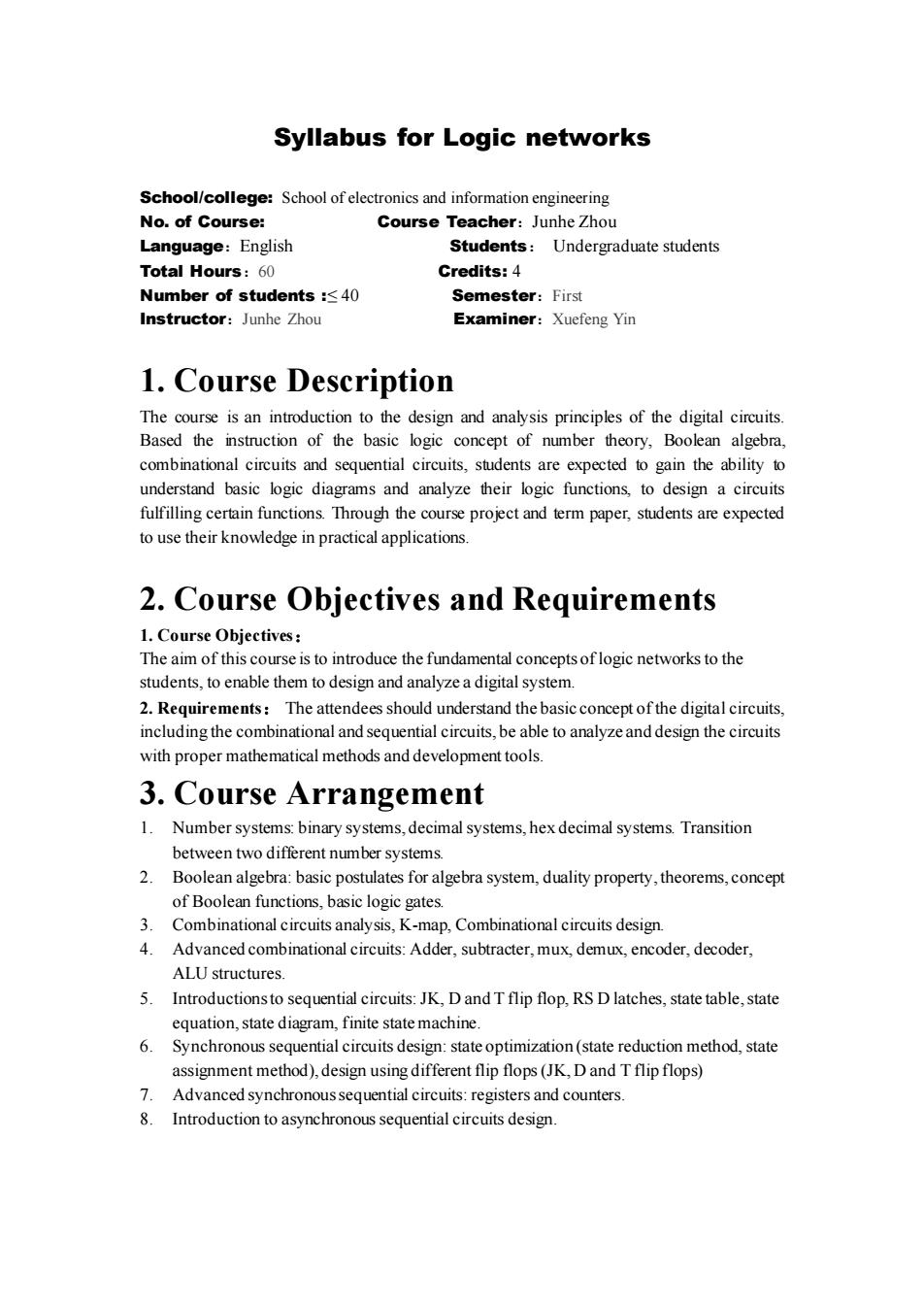正在加载图片...

Syllabus for Logic networks :School of electronics and information engineering No.of Course: Course Teacher:Junhe Zhou Language:English Students:Undergraduate students Total Hours:60 Credits:4 Number of students:40 Sem st Instructor:Junhe Zhou Exa niner:Xuefeng Yin 1.Course Description combinational circuits and sequential circuits,students are expected to gain the ability to understand basic logic diagrams and analyze their logic functions,to design a circuits fulfilling certain functions Through the course project and term paper,students are expected to use their knowledge in practical applications. 2.Course Objectives and Requirements 1.Course Objectives: The aim of this course is to introduce the fundamental conceptsof logic networks to the students,toenable them to design and analyzea digital system 2.Requirements:The attendees should understand the basic concept of the digital circuits. including the combinational and sequential circuits,be able to analyze and design the circuits with proper mathematical methods and development tools. 3.Course Arrangement 1. Number systems:binary systems,decimal systems,hex decimal systems Transition between two different number systems. 2. Boolean algebra:basic postulates for algebra system,duality property.theorems.concept of Boolean functions,basic logic gates. 3.Combinational circuits analysis,K-map,Combinational circuits design. Advanced combinational circuits:Adder,subtracter,mux,demuxencoder,decoder ALUstructures. 5.Introductionsto sequential circuits:JK,DandTflip flop,RSD latches,state table,state equation,state diagram,finite state machine. 6. Synchronous sequential circuits design:stateoptimization(state reduction method,state assignment method).design using different flip fops(JK.DandTflip flops) Advanced synchronoussequential circuits:registers and counters Introduction to asynchronous sequential circuits design. Syllabus for Logic networks School/college: School of electronics and information engineering No. of Course: Course Teacher:Junhe Zhou Language:English Students: Undergraduate students Total Hours:60 Credits: 4 Number of students :≤ 40 Semester:First Instructor:Junhe Zhou Examiner:Xuefeng Yin 1. Course Description The course is an introduction to the design and analysis principles of the digital circuits. Based the instruction of the basic logic concept of number theory, Boolean algebra, combinational circuits and sequential circuits, students are expected to gain the ability to understand basic logic diagrams and analyze their logic functions, to design a circuits fulfilling certain functions. Through the course project and term paper, students are expected to use their knowledge in practical applications. 2. Course Objectives and Requirements 1. Course Objectives: The aim of this course is to introduce the fundamental concepts of logic networks to the students, to enable them to design and analyze a digital system. 2. Requirements: The attendees should understand the basic concept of the digital circuits, including the combinational and sequential circuits, be able to analyze and design the circuits with proper mathematical methods and development tools. 3. Course Arrangement 1. Number systems: binary systems, decimal systems, hex decimal systems. Transition between two different number systems. 2. Boolean algebra: basic postulates for algebra system, duality property, theorems, concept of Boolean functions, basic logic gates. 3. Combinational circuits analysis, K-map, Combinational circuits design. 4. Advanced combinational circuits: Adder, subtracter, mux, demux, encoder, decoder, ALU structures. 5. Introductions to sequential circuits: JK, D and T flip flop, RS D latches, state table, state equation, state diagram, finite state machine. 6. Synchronous sequential circuits design: state optimization (state reduction method, state assignment method), design using different flip flops (JK, D and T flip flops) 7. Advanced synchronous sequential circuits: registers and counters. 8. Introduction to asynchronous sequential circuits design